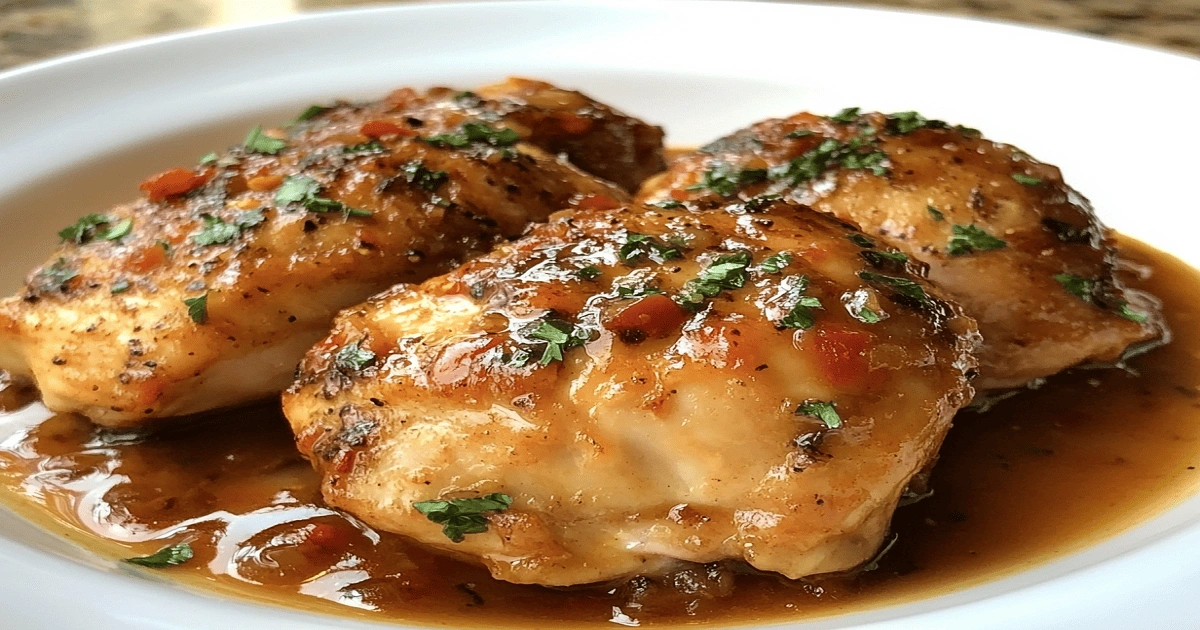Slow cookers promise tender, fall-apart chicken with minimal effort. But what happens when instead of fork-tender meat, you’re met with dry, rubbery disappointment? Many home cooks find themselves asking, why is chicken tough in a slow cooker despite following the instructions. It’s one of the most common frustrations when preparing poultry in a crockpot.
This article addresses exactly that: why chicken turns tough in a slow cooker, what mistakes lead to that, and how you can fix them. With clear, actionable tips, you’ll finally master slow-cooked chicken that’s juicy, tender, and flavorful every single time.
Understanding Slow Cooker Temperatures is essential for preventing tough chicken. Using a slow cooker correctly involves more than just dumping in ingredients and hitting a button.
And yes, there are common mistakes to avoid that silently sabotage your results. Read on to master the art of making perfect slow-cooked chicken—every time.
Why is chicken tough in a slow cooker?
Chicken becomes tough in a slow cooker due to a combination of high temperatures, extended cooking times, insufficient liquid, and poor ingredient choices. Unlike beef or lamb, chicken doesn’t have the same collagen content or fat marbling to protect it during prolonged heat exposure. The key is to control these elements and treat chicken with the precision it deserves.
Why Chicken Turns Tough in a Slow Cooker: The Science Explained
To understand why your chicken turns tough, you first need to understand what slow cooking does. Slow cookers use low, steady heat to break down connective tissues over hours. This method works wonderfully with red meats, where collagen-rich tissues melt into gelatin. Chicken—particularly lean cuts like the breast—contains very little connective tissue compared to other meats.
Once chicken exceeds 165°F (74°C), its proteins contract tightly, forcing out moisture and leaving the meat dry and tough. It’s like wringing a sponge—what remains is dry and fibrous. That’s why knowing your internal temperatures matters.
In particular, chicken breast tends to dry out more easily than other cuts, making it especially sensitive to long cook times and high heat in a slow cooker.
With baking or pan-frying, you get visual signs—browned edges, clear juices—that help you judge doneness. But slow cookers offer no such clues, making it all too easy to overcook chicken if you’re not paying close attention.
Top Reasons Your Chicken Is Tough in the Slow Cooker
1. Cooking It Too Long
Chicken breast is not forgiving. Once it passes the ideal temperature range, it begins to degrade in texture.
-
Boneless breasts need just 2.5–3.5 hours on LOW.
-
Bone-in thighs are more resilient and can handle 6–7 hours.
2. Using High Heat
Using the HIGH setting on a slow cooker might speed things up, but for chicken, it often means drying it out fast:
-
Low and slow is the way to go.
-
High heat is best reserved for tougher cuts like beef brisket or chuck roast.
3. Not Enough Liquid
Liquid prevents scorching and helps regulate internal pot temperature. Chicken without enough liquid dries out—especially if placed on top of other ingredients.
-
Use broth, crushed tomatoes, or coconut milk.
-
Never let chicken sit dry against the hot ceramic base.
4. Wrong Cut of Chicken
Chicken breasts are lean, quick-cooking, and best suited for oven roasting or sautéing. In the slow cooker, they often suffer.
-
Prefer bone-in thighs, drumsticks, or whole leg quarters.
-
Thanks to their fat content and connective tissue, these cuts stay juicy and pack in more flavor as they cook..
5. No Resting Time
Many skip the final, essential step: letting the meat rest. Carving immediately forces the juices to spill out.
-
Let the chicken sit for 5–10 minutes under foil after cooking.
-
It gives the juices time to settle, resulting in a more evenly tender and moist bite.
Time Guide: How Long to Cook Chicken
Not all chicken cuts are created equal—and neither are their cooking times. Using the correct duration for each type helps avoid undercooking or dryness.
| Chicken Cut | Low Setting | High Setting |
|---|---|---|
| Boneless Breasts | 3–4 hours | 1.5–2.5 hours |
| Bone-In Thighs | 5–6 hours | 3–4 hours |
| Whole Chicken | 6–7 hours | 4–5 hours |
| Drumsticks | 4–5 hours | 2.5–3 hours |

Always verify the internal temperature—165°F (74°C) is the benchmark for doneness. Use a thermometer to be precise and avoid guesswork.
And if you’re unsure whether 3 hours is enough in a slow cooker, it’s best to consult a trusted cooking chart or use a probe thermometer for real-time monitoring.
What’s the Best Type of Chicken for Slow Cooking?
Lean meats are sensitive. You need moisture, fat, and bone for the best results in slow cooking. That’s why dark meat wins here.
-
Thighs (bone-in): More flavorful, retain moisture.
-
Drumsticks: Economical, juicy, and hard to overcook.
-
Whole leg quarters: Offer great flavor due to fat and bones.
Avoid skinless, boneless breasts unless the recipe is designed for quick cooking.
Liquid Levels and Sauce Smarts
Always use enough cooking liquid to cover the base of the slow cooker. Liquids act as a buffer, controlling heat and gently steaming the chicken to keep it tender.
Best liquids to use:
-
Chicken or vegetable broth
-
Tomato sauces
-
Coconut milk
-
Cream-based sauces (diluted)
-
Onion and herb broths
Avoid thick sauces unless you thin them with a bit of broth or water. Otherwise, they could burn or create uneven heat zones.
Vegetables Can Save Your Chicken
Yes, really! Strategic placement of vegetables acts as a cushion between the meat and the hot cooker surface.
Use:
-
Onions
-
Carrots

-
Zucchini
-
Mushrooms
-
Bell peppers
Place them underneath or around the chicken. They’ll release moisture and absorb flavor, enhancing the dish’s depth while protecting your chicken from drying out.
Searing: Optional But Useful
Searing locks in flavor and gives chicken a head start in texture. While not essential, it adds color and a caramelized crust that can elevate the final dish.
How to do it:
-
Lightly coat chicken in oil.
-
Sear for 2–3 minutes on each side in a hot pan.
-
Then transfer to the slow cooker with liquids and aromatics.
Searing helps the meat withstand long cooking times and deepens flavor.
Marinades and Brining: The Secret Sauce
To boost juiciness and texture, consider marinating your chicken before slow cooking. Acids like lemon, yogurt, or vinegar tenderize the meat before it ever hits the heat.
Tips:
-
Marinate for 4–12 hours in the fridge.
-
Use ingredients like olive oil, garlic, mustard, and citrus.
-
Pat dry before placing into the cooker to avoid excess steaming.
To go even further, explore expert methods to make chicken tender during cooking. Techniques like proper layering, gentle heat, and correct cook times all contribute to fall-apart results.
When to Add Dairy, Cream, or Cheese?
Dairy breaks down at high heat. For creamy dishes, add milk, cream, or cheese only in the last 30 minutes of cooking. This prevents curdling and preserves flavor.
The Importance of Layering Ingredients
The arrangement inside your cooker matters:
-
Dense ingredients (root vegetables) go at the bottom.
-
Chicken goes in the middle.
-
Liquids and sauces go on top.
This setup allows even heat distribution, prevents burning, and helps infuse the meat with surrounding flavors.
Use Thermometers to Avoid Overcooking
Relying on cook time alone can lead to overcooked, dry chicken—especially in a slow cooker where visual cues are limited. To avoid guesswork, always use a reliable meat thermometer. Insert it into the thickest part of the chicken, being careful not to touch any bone, as that can give a false reading.

Once the internal temperature reaches 165°F (74°C), your chicken is safely cooked and ready to rest. For added convenience, consider using a slow cooker thermometer with a built-in alert. It will notify you the moment your chicken hits the correct temperature, allowing you to avoid overcooking while maintaining juicy, tender results every single time—even if you’re not nearby to check.
FAQs: Why is chicken tough in a slow cooker?
Does chicken breast get softer the longer you cook it in a slow cooker?
No. Unlike red meat, chicken breast does not benefit from extended cook times. In fact, cooking it too long causes the proteins to tighten, squeezing out moisture and making it tough and dry. For best results, remove it as soon as it reaches 165°F (74°C).
How to make tender chicken in a slow cooker?
Use bone-in thighs or drumsticks, cook on the low setting, and ensure there’s enough liquid to keep moisture circulating. For added flavor and tenderness, marinate the chicken beforehand. Also, explore expert methods to make chicken tender during cooking, including correct layering, monitoring internal temperature, and resting the meat before serving.
Is 3 hours long enough for chicken in a slow cooker?
It depends on the cut and the cooker setting. If you’re unsure whether 3 hours is enough in a slow cooker, boneless chicken breasts may be done in 2.5 to 3 hours on low, while bone-in thighs usually require at least 5 hours. Always check the internal temperature to ensure food safety.
Why is my slow cooker chicken not tender?
Common reasons include overcooking, cooking on high heat, or using lean cuts without enough moisture. To improve your results, learn how to stop chicken breast from drying out in a slow cooker. Choosing the right cut, maintaining low heat, and using flavorful broths all contribute to a better texture.
Conclusion: Say Goodbye to Tough Chicken Forever
Slow cooking chicken has the potential to be both convenient and delicious but only when it’s done correctly. If you’ve ever wondered, “Why is chicken tough in a slow cooker?” you’re certainly not alone. The good news is that there are now clear, straightforward answers that can help you avoid this common issue. Understanding what leads to tough, rubbery chicken is the first step. The solution lies in selecting the right cut, maintaining proper liquid ratios, avoiding excessive heat, and being mindful of cooking time.
Delicate by nature especially lean cuts like the breast chicken demands careful, precise cooking. Overcooking it, using high heat, or not adding enough liquid can quickly ruin the texture. Instead, aim to use moisture-rich cuts like bone-in thighs or drumsticks, which are naturally more forgiving. Cooking on the low setting gives you better control and helps preserve juiciness.
Marinating beforehand can also make a big difference, infusing the chicken with flavor and helping it retain moisture during long cooking periods. Using a meat thermometer to monitor doneness ensures you’ll never accidentally overcook it.
With these practical tips and insights, slow cooker chicken can go from disappointing to delightful. Say goodbye to dry, chewy meat and hello to tender, flavorful dishes that will keep your family coming back for seconds.
Next time you slow cook, do it with purpose, knowledge, and confidence.

